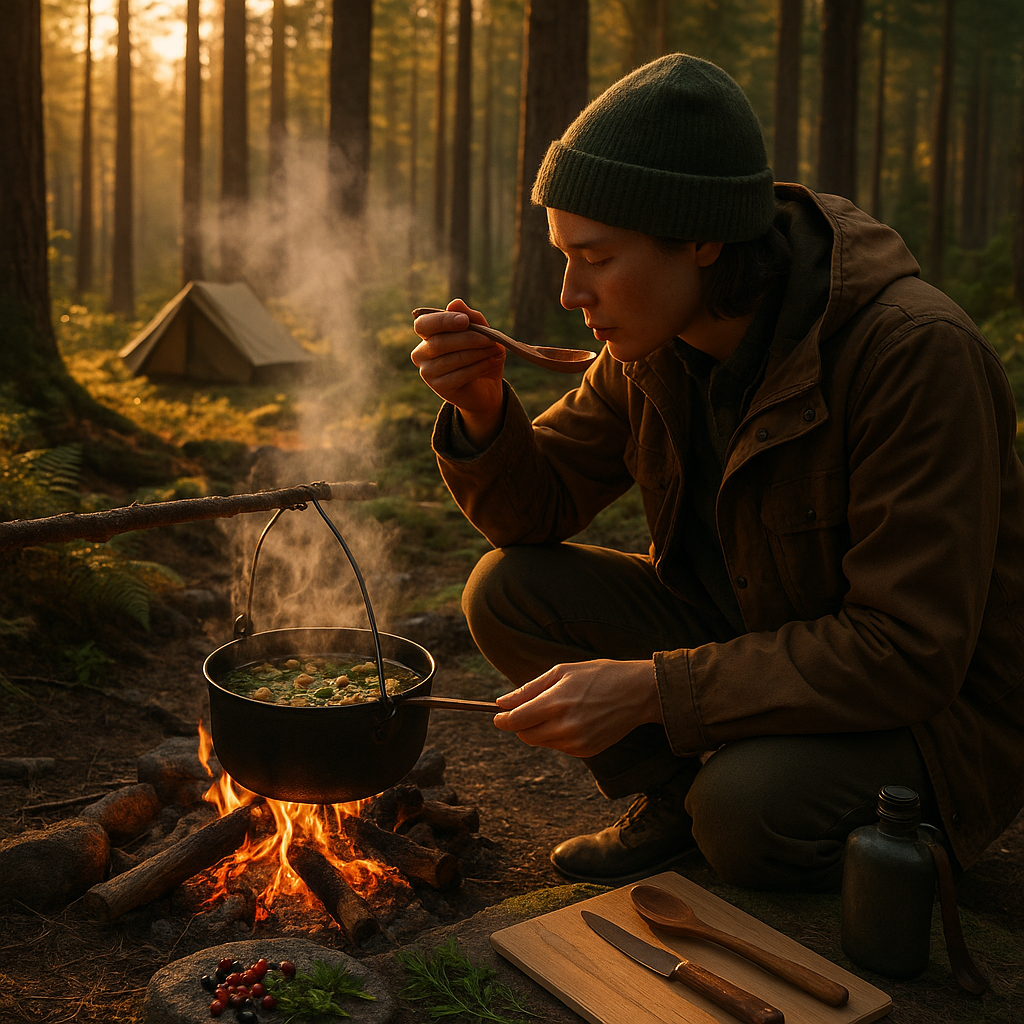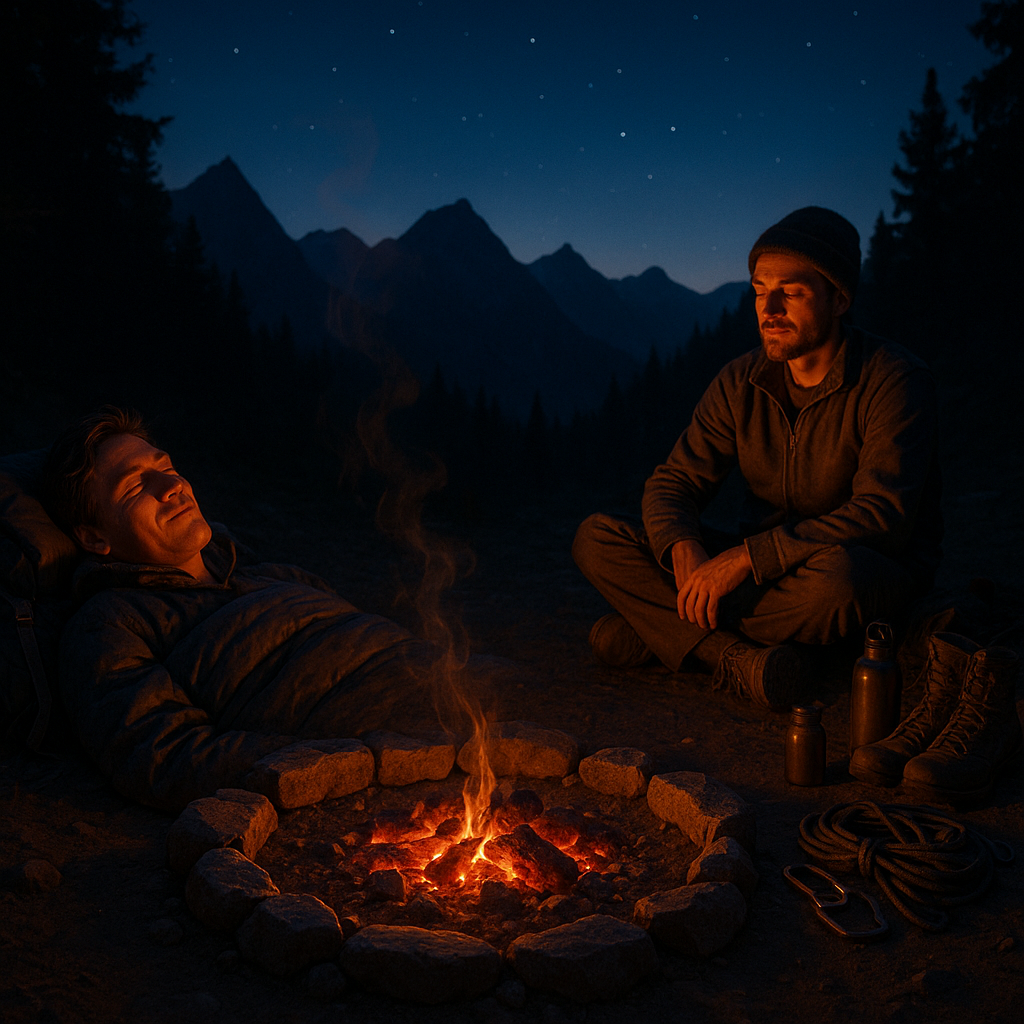Key Takeaways
- Let the fire anchor your wilderness rhythm: In forest life cooking, meals become more than simple pauses; they are anchor points that structure the day’s adventures, encouraging you to slow down and savor not just your food, but the moment itself.
- Simplify with one-flame mastery: Mastering the art of single-flame cooking opens up a world of flavorful and satisfying meals with minimal fuss. Whether you’re simmering a hearty stew or crafting fresh bannock on a stick, a well-tended fire becomes your culinary canvas.
- Forage with confidence and curiosity: Foraging for wild herbs, berries, and edible greens transforms your backpack kitchen, infusing your meals with bursts of authentic, local flavor while nurturing a deeper connection to your surroundings.
- Curate a minimalist but mighty kitchen kit: With only a sturdy pot, fireproof grill, and a sharp knife, forest cooking shifts into a demonstration of elegant simplicity, turning each meal into a celebration of resourcefulness.
- Multiuse meals maximize freedom: One-pot wonders and adaptable recipes allow you to refuel without accumulating clutter, freeing you to focus on exploration, storytelling, and connection shared beside the fire.
- Fire-building is a foundational skill: Tending to your flame (learning how to coax embers, manage heat, and adapt to shifting weather) can be as meditative as cooking itself, grounding you in time-honored rhythms that link past and present.
- Cooking shapes your sense of place: Each meal, every foraged flavor, and the lingering trace of smoke carves a story into the landscape, creating memories and a sense of belonging that linger long after the coals cool.
As you venture further into the world of forest life cooking, let these guiding principles transform routine meals into soulful rituals of connection, creativity, and wild-hearted wonder.
Introduction
A single flame in the forest does much more than cook a meal. It becomes a tether to the living heartbeat of the wilderness, offering warmth and comfort beneath the sprawling canopy. Forest life cooking is not just about satiating hunger; it weaves together the rhythm of adventure, joining sunrise rituals and smoky twilight feasts to create transformative, soulful celebrations.
Embracing the art of one-flame meals and backpack kitchen cooking means trading unnecessary complexity for a deeper sense of wonder, resourcefulness, and connection. With a seasoned hand, a simple pot, and a curious heart, every meal becomes a journey. It is infused with wild flavors gathered beneath the trees and seasoned by both fire and story. Discover how the techniques of wilderness cooking reveal the magic of living, eating, and thriving among the forest’s ancient boughs.
Meals as Ritual: The Heartbeat of Forest Life
When the first strands of sunrise pierce the canopy, hunger emerges as more than just a physical urge. It transforms into an invitation to ritual, a daily ceremony that brings intention and meaning to moments spent outdoors. Each meal, in the practice of forest life cooking, draws us towards the fire not solely for nourishment, but for connection—to ourselves, to our companions, and to the vibrant world that surrounds us.
Stay Sharp. Stay Ahead.
Join our Telegram Channel for exclusive content, real insights,
engage with us and other members and get access to
insider updates, early news and top insights.
 Join the Channel
Join the Channel
Cooking over a single flame turns necessity into a ceremony. The familiar sound of a coffee mug tapping an enamel pot and the sizzle of wild greens as they hit the heat become a grounding, almost musical pulse, especially in a place untouched by clocks or screens. Breakfast can mark the start of new possibilities; the evening meal often signals a return from the day’s wanderings. These mealtime rituals offer comfort, structure, and a wellspring of quiet joy.
Around the fire, strangers can become storytellers. The sharing of food bridges the silence of the wild with laughter and camaraderie, anchoring everyone present. Whether traveling solo or as part of a group, these rituals foster a sense of belonging, offering a chance to celebrate routine and transform it into something soulful and memorable. In this way, forest meals serve as both a gateway to adventure and a return to home.
Let’s now explore the thoughtful choices and essential skills that make forest kitchen magic possible.
Minimalist Gear and the Art of the Backpack Kitchen
A true forest kitchen grows from deliberate simplicity, not excess. Creating your backpack kitchen means choosing only the essentials (tools that are lightweight, versatile, and reliable in the unpredictable rhythm of wild places).
Essential Minimalist Gear:
- Lightweight stove (alcohol, canister, or wood-burning options) to suit various weather conditions
- Single sturdy pot (titanium or hard-anodized aluminum, 1–1.5L capacity for flexibility)
- Long-handled spoon or spork (doubling as stirrer, server, and occasional turner)
- Folding knife or multitool (indispensable for prep and safety)
- Small cutting board (thin, flexible plastic or a slab of wood, could even double as a plate)
- Firestarter kit (ferro rod and windproof matches for reliability)
- Compact cleaning cloth or scraper for effortless cleanup
- Nesting insulated mug to keep drinks warm and pack small
Each piece is chosen with care and purpose. Minimalism in the forest isn’t about going without; it’s about removing barriers between you and the experience of nature, allowing the landscape itself to become your kitchen’s finest backdrop.
With a mindful kit in place, let’s shift to the techniques that transform simple tools into wilderness feasts.
Single Flame, Infinite Possibilities: Core Wilderness Cooking Techniques
Working with a single flame offers a creative challenge, rewarding patience and adaptability with deeply satisfying meals. This limitation inspires innovation, ensuring no ingredient or movement is wasted.
Best Cooking Methods for a Single Flame:
- Simmering: Foundation of countless one-pot meals. Slow, steady heat draws deep flavors out of grains, legumes, and foraged greens.
- Poaching: Delicate eggs or fresh-caught fish, cooked gently in a simmering broth, become the ultimate camp comfort food.
- Sautéing: Even a humble dash of oil can transform local aromatics and just-foraged finds into layered, irresistible bites.
- Grilling on embers: As the fire settles, glowing coals await skewered mushrooms, wild onions, or a rustic bannock dough pressed onto sticks.
- Steam-cooking: Place a few clean pebbles in your pot, add water, then nestle wild greens or fish atop for a tender, fragrant result.
Tips for One-Flame Efficiency:
Start with ingredients requiring the most time (like grains), then add quicker-cooking items (green vegetables, tender fish) later on. Secure your pot behind a boulder or in a hollow to block wind and maximize heat, and use lids whenever possible to conserve fuel and moisture.
Mastering these essential cooking techniques with limited gear opens unlimited culinary potential, letting you explore creativity without the burden of bulky equipment.
Wild Flavor: Foraging and Local Ingredients
The richness of the forest reveals itself through its edible treasures. Cooking with what the wild provides not only intensifies the flavor of each meal but also forges a deeper connection to the land itself.
Key Foraging Practices:
Always harvest plants, mushrooms, or berries you can confidently identify: wild ramps, watercress, wood sorrel, and chicken-of-the-woods mushrooms are some rewarding options in many regions. A compact field guide is invaluable, and learning from local experts or joining foraging walks expands both knowledge and safety.
Incorporating wild ingredients elevates meals, turning your backpack kitchen into an ongoing dialogue with your environment. Add spruce tips to simmering grains, steep wild mint for tea, or quickly sauté oyster mushrooms in a splash of oil. Each meal is rich with place, season, and story.
Practicing mindful harvesting and moderation ensures the landscape is cared for, fostering sustainability and respect. Whether you’re hiking wooded trails, exploring riversides, or camping near mountain vistas, wild flavors invite adventure and creativity into every dish. You may even want to try enhancing your meals with sun-dried herbs and nature-cured spices for an extra burst of authentic taste.
The art of foraging enriches meal planning, transforming it into a celebration of discovery and resourcefulness.
Stay Sharp. Stay Ahead.
Join our Telegram Channel for exclusive content, real insights,
engage with us and other members and get access to
insider updates, early news and top insights.
 Join the Channel
Join the Channel
Recipe Stories from the Forest: One-Pot Wonders
Forest meals shine brightest in their simplicity. One-pot recipes are not just practical; they are invitations to culinary creativity, easy cleanup, and unhurried enjoyment surrounded by nature’s beauty.
Practical One-Pot Meal Ideas:
- Morning Mist Porridge: Cook rolled oats with water drawn from a nearby stream (carefully filtered), then stir in plump berries and toasted pine nuts. Rosehips, wild-harvested, add a tangy spark.
- Riverbank Stew: Sauté onions and garlic with chunks of root vegetables, toss in lentils and wild greens, then simmer with broth and spice until hearty and filling. Perfect after a day’s trek.
- Forest Pilaf: Toast wild rice with bits of sausage, sun-dried tomatoes, and fresh-picked mushrooms. Add water, let simmer, then finish with hand-harvested herbs.
- One-Flame Flatbread: Mix flour, water, and a pinch of salt for a quick dough, flatten, and cook directly on stones beside the fire for a rustic, satisfying bite.
Meal Planning Tips:
Travel with adaptable staples: lentils, grains, seasoning tins. Make room for spontaneity by swapping planned ingredients for freshly foraged finds, and keep meal components flexible to accommodate changing conditions. After a full day outdoors, generosity in portion size will always be appreciated.
These recipes are joyful by nature—simple, adaptable, and deeply satisfying. They foster a rhythm of planning balanced by wild improvisation, ensuring that every forest meal is a celebration of place and possibility. For more inspiration from sacred gatherings, consider learning from recipes and rituals of remote fire circles.
Adaptability and Creativity: Making Magic with What You Have
Wilderness cooking is a living lesson in adaptability. Changes in weather, unexpected harvests, or shifts in your itinerary often reshape meal plans, urging creativity and resourcefulness.
Creative Approaches in Forest Life Cooking:
- Use hollowed wood, flat stones, or large leaves as impromptu cooking vessels or platters.
- Transform yesterday’s leftovers. Charred potatoes become a morning hash topped with wild herbs or a freshly poached egg.
- Harness the elements: use the wind to gently smoke meats, chill dough in a cool stream, or let the sun dry slices of fruit for snacks.
These moments are the essence of adventure living. Instead of viewing limitations as challenges, see them as invitations to experiment. Each meal is an opportunity to connect with the environment and your companions in new, inventive ways.
Across different cultures and traditions, adaptability emerges as a universal thread in outdoor cooking, shaping dishes that are both nourishing and memorable. Whether along a misty riverbank, alpine meadow, or deep forest glade, embracing the unexpected encourages both culinary artistry and heartfelt connection.
For those interested in how weather shapes forest and seaside cooking, discover techniques and stories for cooking creative meals during storms.
Broader Inspiration: Forest Kitchens Beyond Adventure
While forest cooking is often associated with backpacking and wild exploration, its spirit extends into other domains as well. In eco-tourism lodges, sustainable resorts, and even urban rooftop gardens, the principles of minimalist cooking, local sourcing, and adaptability are increasingly valued.
Healthcare professionals recognize the therapeutic benefits of outdoor meal rituals, offering both mental respite and physical activity. Educational programs now teach foraging and primitive cooking skills, nurturing self-sufficiency in both children and adults.
Even in legal contexts, respecting local foraging regulations is vital for sustainable practice. Environmental scientists advocate for mindful harvesting to maintain delicate ecological balances.
Culinary professionals, food marketers, and farm-to-table movements are also inspired by these traditions, finding fresh storytelling and new flavors to share with broader audiences. The lessons learned around a campfire ripple far beyond the forest’s edge. If you’re curious about the deeper roots of outdoor cooking, explore the rich legacy of indigenous foodways and traditional wisdom.
Conclusion
In the wild hush of the forest, cooking with a single flame transcends mere survival. It evolves into a profound journey of connection, creative expression, and reverence for the land. Minimalist tools and foraged ingredients draw us toward a style of cooking that cherishes both simplicity and the intricate beauty of nature. Each meal, from sunrise porridge to riverbank stew, is seasoned with stories, ingenuity, and a spirit of soulful adventure.
The rituals formed around open flames do more than provide nourishment; they anchor us in shared moments of laughter, reflection, and wonder. Through adaptability and mindful respect, we rediscover freedom, creating sustenance, memories, and meaning among the wildest places.
Looking forward, the future of outdoor and forest-inspired cooking lies in continued creativity, sustainability, and connection with both local ecosystems and each other. Whether you are a solo wanderer, a family of explorers, or a chef bringing wild flavors to the city table, the true magic is found in embracing resourcefulness, seeking authentic moments, and letting every meal become a celebration of food, fire, and freedom. The next chapter is yours to write. Gather your gear, build your fire, and taste the world beyond the digital noise.
List of Inserted Links
- backpack kitchen cooking – Essential Outdoor Emergency Tools Every Campfire Chef Needs
- sun-dried herbs and nature-cured spices – Sun-Dried Herbs: Nature’s Age-Old Secret for Flavorful Outdoor Feasts
- recipes and rituals of remote fire circles – Fire Circles: Recipes, Rituals & Stories of Sacred Gatherings
- cooking creative meals during storms – Storm Meals: Creative Outdoor Cooking Adventures in the Rain
- indigenous foodways and traditional wisdom – Indigenous Foodways: Fire, Tradition & Wisdom in Outdoor Cooking





Leave a Reply